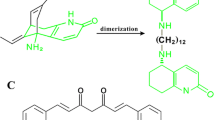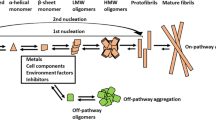Abstract
Alzheimer's disease (AD) and type 2 diabetes (T2D) are common diseases in the elderly, and the increasing number of patients with these diseases has become a serious health problem worldwide. The aggregation and development of plaque of amyloid polypeptides (amyloid β; Aβ and human islet amyloid polypeptide; hIAPP, amylin) are found in the brains of patients with AD and the pancreas of patients with T2D and are considered to be, in part, the causes of both diseases, respectively. Therefore, preventing amyloid aggregation may be a promising therapeutic strategy for preventing AD and T2D. In addition, the disaggregation of the already aggregated amyloid polypeptides is expected to contribute to the prevention and treatment of both diseases as amyloid polypeptide aggregations begin several decades before the onset of disease. Therefore, in this study, we investigated the hIAPP aggregation inhibitory activity and Aβ42/hIAPP disaggregation activity of clovamide which had shown inhibitory activity against Aβ42 aggregation in our previous studies. In addition, active sites were identified (structure–activity relationship analysis) using clovamide-related compounds in which hydroxyl groups of these compounds were either eliminated or methylated. Our results showed that the compounds with one or two catechol moieties showed strong hIAPP aggregation inhibitory activity and Aβ42/hIAPP disaggregation activity; and the non-catechol type compounds showed little or no activity. This suggests that the catechol moiety is important in amyloid polypeptide aggregation inhibition and disaggregation. Thus, clovamide and its related compounds may be promising therapeutic strategies for inhibiting amyloid polypeptide-related pathology in AD and T2D.







Similar content being viewed by others
References
Eisenberg D, Jucker M (2012) The amyloid state of proteins in human diseases. Cell 148:1188–1203
Johnson KH, O’Brien TD, Hayden DW, Jordan K, Ghobrial HK, Mahoney WC, Westermark P (1988) Immunolocalization of islet amyloid polypeptide (IAPP) in pancreatic beta cells by means of peroxidase-antiperoxidase (PAP) and protein A-gold techniques. Am J Pathol 130:1–8
Masters CL, Simms G, Weinman NA, Multhaup G, McDonald BL, Beyreuther K (1985) Amyloid plaque core protein in Alzheimer disease and Down syndrome. Proc Natl Acad Sci USA 82:4245–4249
Haass C, Selkoe DJ (2007) Soluble protein oligomers in neurodegeneration: lessons from the Alzheimer’s amyloid beta-peptide. Nat Rev Mol Cell Biol 8:101–112
Cooper GJ, Leighton B, Dimitriadis GD, Parry-Billings M, Kowalchuk JM, Howland K, Rothbard JB, Willis AC, Reid KB (1988) Amylin found in amyloid deposits in human type 2 diabetes mellitus may be a hormone that regulates glycogen metabolism in skeletal muscle. Proc Natl Acad Sci USA 85:7763–7767
Oskarsson ME, Paulsson JF, Schultz SW, Ingelsson M, Westermark P, Westermark GT (2015) In vivo seeding and cross-seeding of localized amyloidosis a molecular link between type 2 diabetes and Alzheimer disease. Am J Pathol 185:834–846
Wijesekara N, Ahrens R, Sabale M, Wu L, Ha K, Verdile G, Fraser PE (2017) Amyloid-β and islet amyloid pathologies link Alzheimer’s disease and type 2 diabetes in a transgenic model. FASEB J 31:5409–5418
Gravitz L (2011) Drugs: a tangled web of targets. Nature 475:S9–S11
Miyamae Y, Kurisu M, Murakami K, Han J, Isoda H, Irie K, Shigemori H (2012) Protective effects of caffeoylquinic acids on the aggregation and neurotoxicity of the 42-residue amyloid β-protein. Bioorg Med Chem 19:5844–5849
Kurisu M, Miyamae Y, Murakami K, Han J, Isoda H, Irie K, Shigemori H (2013) Inhibition of amyloid β aggregation by acteoside, a phenylethanoid glycoside. Biosci Biotechnol Biochem 77:1329–1332
Hmidene AB, Hanaki M, Murakami K, Irie K, Isoda H, Shigemori H (2017) Inhibitory activities of antioxidant flavonoids from Tamarix gallica on amyloid aggregation related to Alzheimer’s and type 2 diabetes diseases. Biol Pharm Bull 40:238–241
Jiang G, Takase M, Aihara Y, Shigemori H (2020) Inhibitory activities of kukoamines A and B from Lycii Cortex on amyloid aggregation related to Alzheimer’s disease and type 2 diabetes. J Nat Med 74:247–251
Sun J, Jiang G, Shigemori H (2019) Inhibitory activity on amyloid aggregation of rosmarinic acid and its substructures from Isodon japonicas. Nat Prod Commun 2019:1–5
Sun J, Murata T, Shigemori H (2020) Inhibitory activities of phenylpropanoids from Lycopus lucidus on amyloid aggregation related to Alzheimer’s disease and type 2 diabetes. J Nat Med 74:579–583
Tsunoda T, Takase M, Shigemori H (2018) Structure-activity relationship of clovamide and its related compounds for the inhibition of amyloid β aggregation. Bioorg Med Chem 26:3202–3209
Naiki H, Gejyo F (1999) Kinetic analysis of amyloid fibril formation. Methods Enzymol 309:305–318
Murakami K, Irie K, Morimoto A, Ohigashi H, Shindo M, Nagao M, Shimizu T, Shirasawa T (2003) Neurotoxicity and physicochemical properties of Aβ mutant peptides from cerebral amyloid angiopathy. J Biol Chem 278:46179–46187
Ono K, Hasegawa K, Naiki H, Yamada M (2004) Curcumin has potent anti-amyloidogenic effects for Alzheimer’s beta-amyloid fibrils in vitro. J Neurosci Res 75:742–750
Mirhashemi SM, Aarabi MH (2012) Effect of two herbal polyphenol compounds on human amylin amyloid formation and destabilization. J Med Plants Res 6:3207–3212
Ishii T, Mori T, Tanaka T, Mizuno D, Yamaji R, Kumazawa S, Nakayama T, Akagawa M (2008) Covalent modification of proteins by green tea polyphenol (–)-epigallocatechin-3-gallate through autoxidation. Free Radic Biol Med 45:1384–1394
Sato M, Murakami K, Uno M, Nakagawa Y, Katayama S, Akagi K, Masuda Y, Takegoshi K, Irie K (2013) Site-specific inhibitory mechanism for amyloid β42 aggregation by catechol-type flavonoids targeting the Lys residues. J Biol Chem 288:23212–23224
Bittner S (2006) When quinones meet amino acids: chemical, physical and biological consequences. Amino Acids 30:205–224
Du WJ, Guo JJ, Gao MT, Hu SQ, Dong XY, Han YF, Liu FF, Jiang S, Sun Y (2015) Brazilin inhibits amyloid β-protein fibrillogenesis, remodels amyloid fibrils and reduces amyloid cytotoxicity. Sci Rep 5:7992–8002
Choi EY, Kang SS, Lee SK, Han BH (2020) Polyphenolic Biflavonoids inhibit amyloid-beta fibrillation and disaggregate preformed amyloid-beta fibrils. Biomol Ther 28:145–151
Li J, Zhu M, Manning-Bog AB, Di Monte DA, Fink AL (2004) Dopamine and l-dopa disaggregate amyloid fibrils: implications for Parkinson’s and Alzheimer’s disease. FASEB J 18:962–964
Ren B, Liu Y, Zhang Y, Zhang M, Sun Y, Liang G, Xu J, Zheng J (2018) Tanshinones inhibit hIAPP aggregation, disaggregate preformed hIAPP fibrils, and protect cultured cells. J Mater Chem B 6:56–67
Ono K, Hamaguchi T, Naiki H, Yamada M (2006) Anti-amyloidogenic effects of antioxidants: implications for the prevention and therapeutics of Alzheimer’s disease. Biochim Biophys Acta 1762:575–586
Acknowledgements
We thank Professor Kazuhiro Irie, Associate Professor Kazuma Murakami, and Dr. Mizuho Hanaki, Graduate School of Agriculture, Kyoto University for preparing Aβ42. The analysis of clovamide and its related compounds was carried out with AVANCE-500 at Chemical Analysis Division and the Open Facility, Research Facility Center for Science and Technology, University of Tsukuba. We would like to thank Editage (www.editage.com) for English language editing. This work was partially supported by JSPS KAKENHI Grant Number JP24580156.
Author information
Authors and Affiliations
Corresponding author
Additional information
Publisher's Note
Springer Nature remains neutral with regard to jurisdictional claims in published maps and institutional affiliations.
Supplementary Information
Below is the link to the electronic supplementary material.
Rights and permissions
About this article
Cite this article
Nomoto, D., Tsunoda, T. & Shigemori, H. Effects of clovamide and its related compounds on the aggregations of amyloid polypeptides. J Nat Med 75, 299–307 (2021). https://doi.org/10.1007/s11418-020-01467-w
Received:
Accepted:
Published:
Issue Date:
DOI: https://doi.org/10.1007/s11418-020-01467-w




